Flowers, apples, artichokes and other lessons from 2017
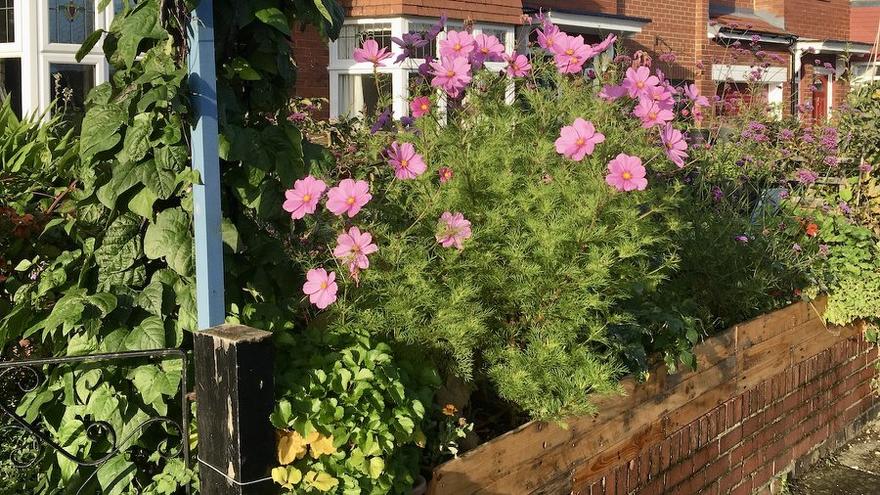
Growing is endlessly fascinating as there’s always more to learn. As winter approaches, it's a good time to reflect on the successes and learning of the season. Here are five (of the many!) things I learnt in 2017.
1. Grow veg AND flowers
This year, I grew more flowers. In amongst the salads, herbs and fruits, I planted cosmos, verbena, along with edible flowers like cornflower, borage, nasturtium and pansies.
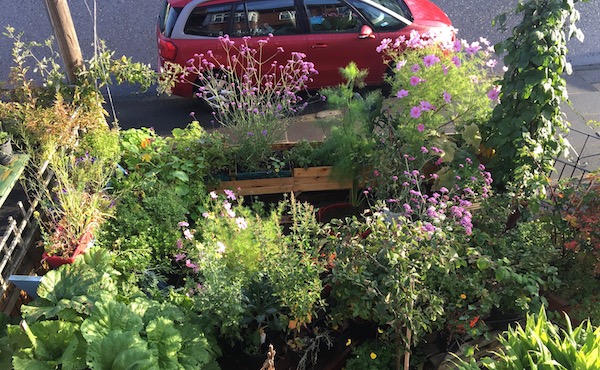
Late summer: the cosmos and verbena add colour.
As my front yard growing space is in public view, I wanted to create a more colourful and interesting display - and it certainly seemed to help spark up more conversations with passers-by! It also provided cut flowers for inside (and to give away), pretty edible flowers for salads, and nectar for the bees. 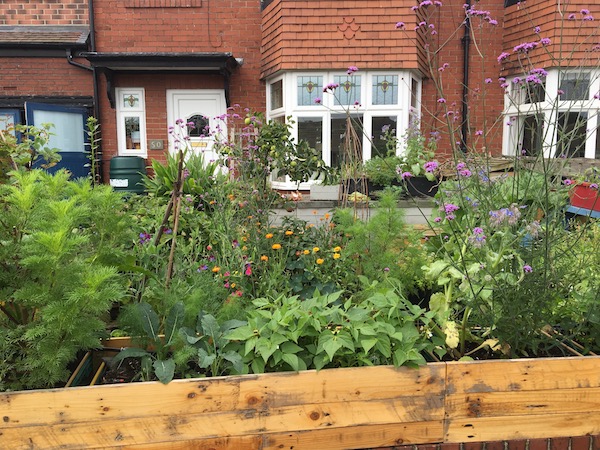
Mixing with veg adds colour, attracts bees, and some of these flowers are edible, too.
The French have a history of creating beautiful vegetable gardens in public view (they call them 'potager' gardens). Here in the UK, veg plants are often viewed as lower class citizens, hidden away. This is a shame - some people who live in cities only ever get to see vegetables confined to plastic bags in the supermarket. By creating attractive edible gardens in the concrete spaces or windowsills at the front of the home, we can help give vegetables the profile they deserve! (I'm a big fan of the Incredible Edible Network for this reason).
2. Apples and other larger fruits
Strawberries, blueberries and most other berries make excellent container crops for small spaces, often fruiting well in their first or second year. But what about larger fruit trees?
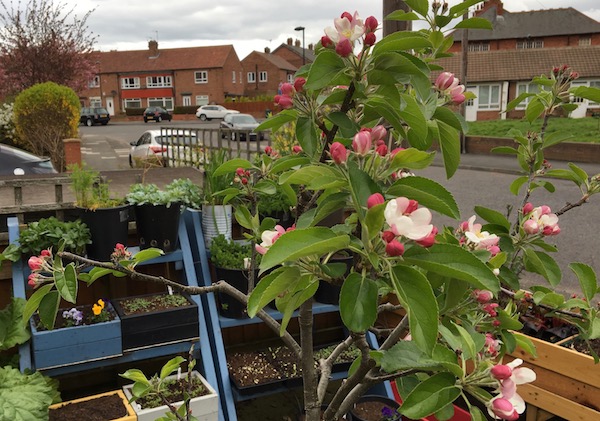
The apple blossom is a beautiful and welcome sign of spring - good for bees, too.
I’ve been experimenting with an apple tree in a pot for six years. It’s given beautiful spring blossom, but only a handful of apples each year. I confess I’ve questioned if it was worth the space. But this year, it produced over 40 delicious apples. It was a joy! The investment of time finally felt worthwhile.

After six years (and four different homes), this apple finally produces an excellent crop of apples. Delicious, too.
On the other hand, the hardy kiwi fruit I’ve been growing for four years has yet to produce even one fruit. It did produce its first (very pretty) flower this year, so I’m not giving up on it…. Yet!

The hardy kiwi flowered for the first time this year - unfortunately all the blossom was then blown off by a storm!
My experience with these larger fruits so far suggests they usually take several years to be productive - and can be a bit of lottery (I also had a plum that never fruited). This makes them less suitable if you've very little space or are living in short term accommodation (unless you grow them for the blossom). But if you have the space, time and patience, they may turn out rather well - and they can add height and form to a container garden. But in most small spaces, I’d probably stick with the berries. If you've tried growing any of the larger fruit trees in a container - apple, pear, mulberry, peach, fig etc - I'd love to hear about your experience in the comments.
3. Discovering new microgreens
At the other end of the spectrum from fruit trees, microgreens are one of the fastest growing choices. I’ve long championed pea shoots, fava shoots, rocket, coriander and mixed mustards. This year, I created a new online course, How to Grow Amazing Salads, which proved a good excuse to try a whole array of new micro greens. Amongst those I particularly enjoyed were nasturtium (pretty round leaves), basil (vibrant flavour) and Amaranth Red Army (vivid magenta leaves).
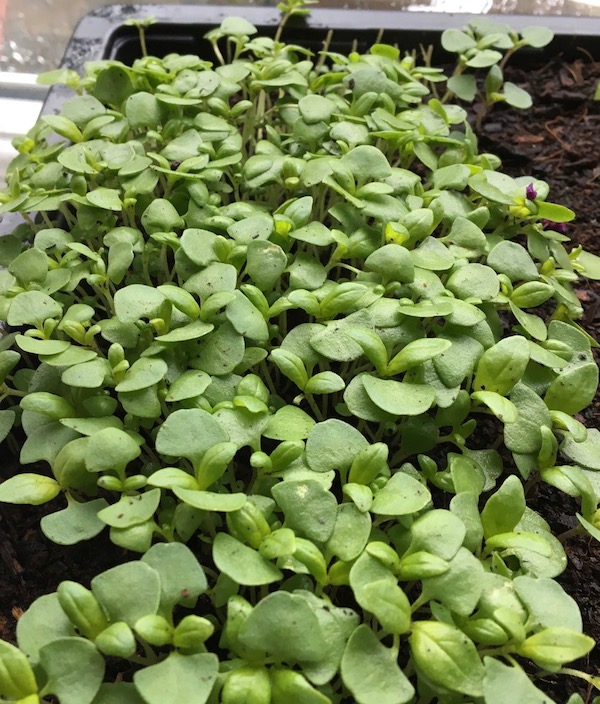
This micro basil has a wonderful, vibrant flavour. Grown from basil seeds found in the spice section of the local Asian store!
Easy to grow and delicious - I highly recommend experimenting with microgreens if you haven't already.
4. Are automatic watering systems a good idea?
Several years ago, I ordered an automatic watering system - pipes, drippers and a timer. When it arrived, I was busy with work and children and it just seemed too fiddly and time consuming to install. I'm ashamed to say it gathered dust in the loft. This year I bit the bullet. It did take me a while to get my head round how to put it together (definitely scope for clearer instructions and videos to help). But it did become clearer and easier as I worked on it. It doesn’t fully solve the watering issue – not all the plants have drippers (I have too many pots!), and those that do sometimes need more water. But it does save a huge amount of time, cutting my watering from 15 minutes a day to 5 minutes or less. And, if I’m unable to water one day, the plants are less badly affected. I also noticed that some of the plants that like good watering – like runner beans – did seem to grow happier and more lush with regular water from drippers twice a day. Unless you go away a lot, I’d be hesitant to recommend these systems for smaller container gardens. But if your watering takes you a long time every day or seems a chore, it's definitely a good option to consider.
5. Jerusalem artichokes in containers?
Jerusalem artichokes are delicious (in my humble opinion), and hard to find in most UK stores. They are big plants (they also make good windbreaks) - grow easily in the ground. But how easy are they to grow in containers? From past experience, I know they do well in a big, deep container, but this year I thought it would be interesting to see if they'll grow OK in a smaller, supermarket vegetable crate (about 6 in / 15 cm deep - and 2ft / 60cm x 1.5ft 40cm wide) . The plants grew really well, reaching well over eight feet tall. I will harvest them as a treat in the early spring and it will be interesting to see how many tubers are produced.
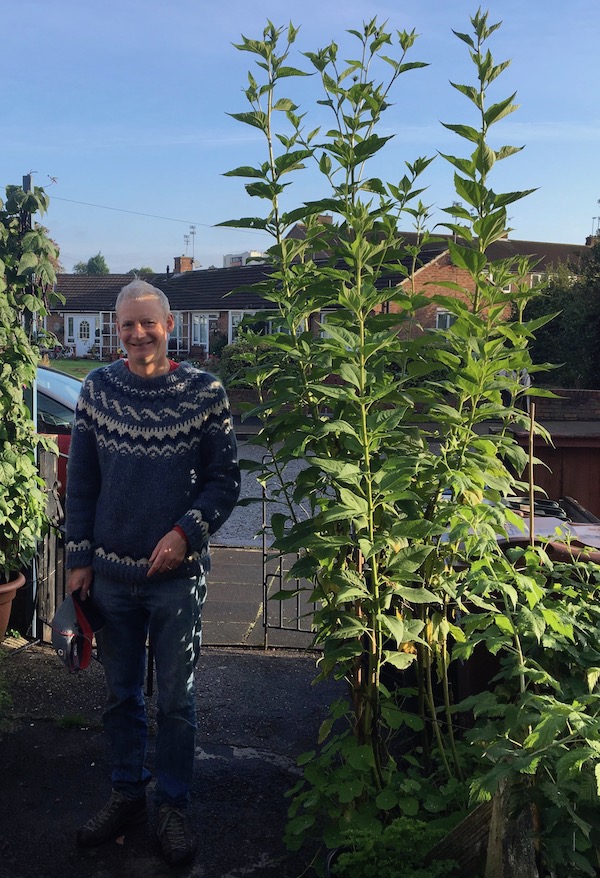
The Jerusalem artichokes grew over 8 feet tall in a container just six inches (15cm) deep.
Your Turn
I'd love to hear about your learning this year in the comments below. And, if you've tried growing fruit trees or artichokes or set up an automatic watering system, what did you find?

35 comments
Leave a comment